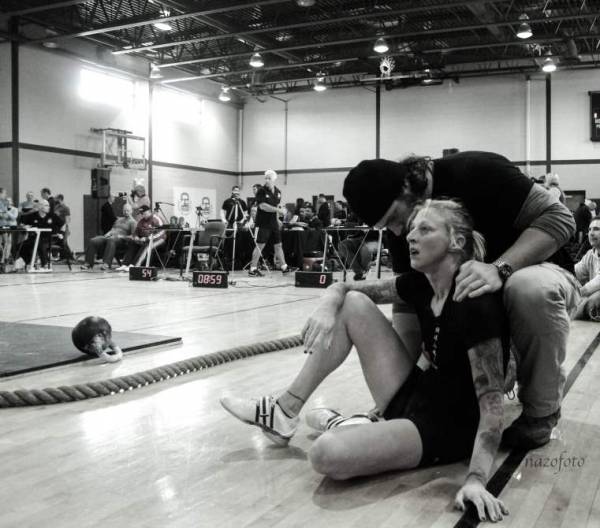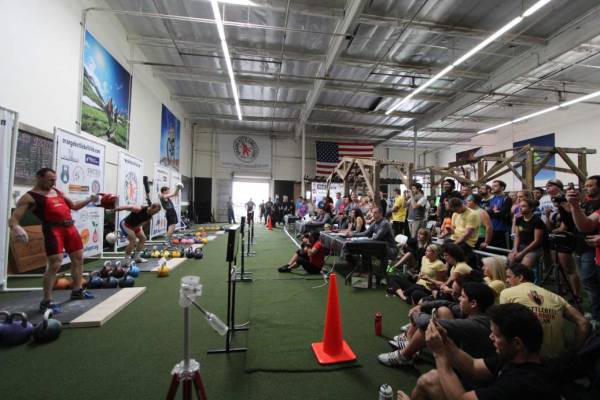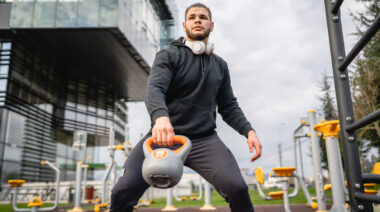My first Kettlebell Sport meet broke a nine-year competitive dry spell. It was the first time I had participated in any official athletic event since my freshman year of high school. So when I entered the competitive world of kettlebell lifting, I really had no idea what to expect.
Now, after three years, I’m sharing what I’ve learned – from both personal experience and anecdotal experiences of fellow lifters. While the following was written with Kettlebell Sport in mind, many of the concepts and strategies are applicable to any kind of competition preparation.
Bring Your Own Gear
If you use it in training, take it with you. I treat my gym bag like my home away from home, trying to anticipate every possible need while I’m away. The only fair assumption is that you will be provided with kettlebells. That’s it – you can’t depend on anything else.
Plan on bringing your own chalk, spray bottle, and mobility tools, as well as your lifting shoes, belt, wrist protection, and lucky headbands. Not only will this ensure you have the perfect firmness of foam roller that your muscles require, but these little comforts from home will make the meet feel like just another training day. Remember, staying relaxed and anxiety-free is your top priority. No one wants a panic attack because the mist setting on the gym’s spray bottle doesn’t adequately wet your shirt.
Make sure your gear meets the organization’s rules and regulations, which often outline requirements for thickness and width of belts and wrist protection, length of short and shirts, and knee wraps. Seek this information in advance and if your gear isn’t regulation, find a replacement and start training with it immediately. If you’re not sure about a particular item, try to set a time with the meet organizer in advance to allow him or her to inspect it – but be prepared for an unfavorable decision and have a backup.
How to Manage Your Nerves
Competition is inherently stressful. It’s the climactic finish to a grueling training cycle, weeks or months of paying careful attention to your diet – especially if you had to cut weight – and it all comes down to ten minutes.
It’s been said in countless articles and blog posts, but I’m going to say it again: nerves are a good thing. It shows that you care, that this moment is important. However, spending the day in complete and intense anxiety is only going to hurt your result, so it’s essential you stay relaxed and centered. Think Matthew McConaughey in a hammock at the beach. Relax.
Music, meditation, visualization practices, or having a close (but calm) friend nearby are all great ways to ensure your nerves don’t get the best of you. But these have to be tested methods. If you never meditate, then the electric competition atmosphere is probably not the best place to start. There is so much drama and excitement from success or failure, seeing new and old friends, and preparing for your own sets. Allowing yourself to get sucked into all of it for hours on end will leave you emotionally drained and physically exhausted.
Personally, I like to go for a little walk outside before I start my warm up. The fresh air soothes me and the fresh surroundings are a welcome distraction from the intensity inside. If that’s not possible, due to weather or location, I go sit by myself for a while in a different room, away from all the noise, and listen to some music while I play on my phone. I just chill.

Goal Setting for Competition
While it’s essential to set some sort of competition goal, I’ve found that having multiple or, better yet, a tiered series of goals is best. If you’re like me, setting a new personal record (PR) can still be a letdown. Did I hold out? Could I have pushed even harder?
To avoid, or at least reduce, the inevitable disappointment, consider setting tiered goals for each competition. Start with the minimum result for you to feel satisfied. For me it’s my previous PR +1. It’s concrete, irrefutable progress. Maybe not as good as I was hoping for, but a PR is a PR.
Next is my real goal – the number I’ve been training for and is usually ten to fifteen percent above my previous PR. So, if I did sixty jerks last time, then I’m looking for around 67 this time. If I hit this number, the day is won. I will leave happy and probably enjoy some victory doughnuts.
And last is the stretch goal, which is usually just a few reps higher than my main goal. So using sixty again as my previous best, 61 is my minimum, 67 is the main goal, and then seventy or above would be my stretch. If I hit my stretch, I’m ecstatic. I feel like a champion.
Setting multiple goals puts success on a spectrum rather than in black or white, and will relieve some of the paralyzing pressure athletes can place on themselves to reach a particular result. For any lifter, I strongly believe that surviving the ten-minute timeframe should be the first milestone. After all, Kettlebell Sport is an endurance sport and going the distance is part of that.
Pacing Strategy
A competition pacing strategy should first and foremost be realistic and developed in the time leading up to competition. That is, it should follow the progression of the training cycle. Your training, both mental and physical, will have been focused on the demands of a particular pace.
While this may seem straightforward and obvious, the competition atmosphere can be intoxicating and many lifters indulge their nerves by going too quickly when the clock starts. Soon, they find themselves moving at a pace they cannot maintain and they panic – increasing their heart rate and losing their judgment. The result, more often than not, is an early hand switch, a dropped bell, or an abrupt stop to the set.
While it’s essential to have a plan, it’s still important to remain flexible and not be a slave to the clock. I don’t care how many motivational gym photos you’ve posted, you’re not a machine. Attempting to be too mechanical with your pace (for example, a strict one rep every six seconds) could be problematic if it means forcing yourself into a rep when you aren’t ready. Instead, allow yourself to be up or down a rep each minute – go by feel, rather than the clock.
Planning for a personal record is like staring into the unknown. It’s a little daunting and you’re unsure of how you’ll respond physically and emotionally to the increased stress. But well planned, yet flexible pacing strategy is your light in the darkness.

Takeaway
- Gear: If you don’t use it in training, don’t use it in competition. Make sure it meets the organization’s regulations before the meet.
- Nerves: Keep yourself calm and relaxed throughout the day to manage pre-competition nerves. Whichever method you decide, develop that routine in advance.
- Goal Setting: Consider a tiered system to put success on a spectrum, rather than all or nothing. This keeps your results in perspective.
- Pacing: Have a flexible strategy to reach your goal. Don’t be a slave to the clock, go by how you’re feeling.






